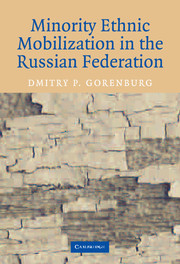Book contents
- Frontmatter
- Contents
- List of Figures and Tables
- Preface
- 1 Minority Ethnic Mobilization in Russia: An Introduction
- 2 Explaining Ethnic Mobilization: The Role of Ethnic Institutions
- 3 From Cultural Society to Popular Front: The Formation and Development of Nationalist Organizations
- 4 The Soviet Institutional Legacy and Ethno-Nationalist Ideology
- 5 Institutions Matter: Measuring Support for Nationalism
- 6 Intragroup Variation in Support for Nationalism: Not All Ethnics Are the Same
- 7 Outcomes: Did Regional Governments Adopt the Nationalist Agenda?
- 8 The Larger Picture: Support for Nationalism in Russia's Other Republics
- 9 Institutions and Nationalism
- Appendix: Construction of Variables and Indices
- References
- Index
3 - From Cultural Society to Popular Front: The Formation and Development of Nationalist Organizations
Published online by Cambridge University Press: 15 December 2009
- Frontmatter
- Contents
- List of Figures and Tables
- Preface
- 1 Minority Ethnic Mobilization in Russia: An Introduction
- 2 Explaining Ethnic Mobilization: The Role of Ethnic Institutions
- 3 From Cultural Society to Popular Front: The Formation and Development of Nationalist Organizations
- 4 The Soviet Institutional Legacy and Ethno-Nationalist Ideology
- 5 Institutions Matter: Measuring Support for Nationalism
- 6 Intragroup Variation in Support for Nationalism: Not All Ethnics Are the Same
- 7 Outcomes: Did Regional Governments Adopt the Nationalist Agenda?
- 8 The Larger Picture: Support for Nationalism in Russia's Other Republics
- 9 Institutions and Nationalism
- Appendix: Construction of Variables and Indices
- References
- Index
Summary
How did it come about that a regime that had experienced virtually no political opposition suddenly was faced with powerful protest movements that threatened the country's integrity? How did nationalist organizations appear, gain strength, and spread throughout each republic in societies with no history of independent political associational life, and where nationalism was condemned? Even in states that have strong civil societies and do not suppress nationalism, political organizers face formidable obstacles. Since Mancur Olson first described the free-rider problem in The Logic of Collective Action (1965), the formation of groups for the purpose of achieving political goals has been seen as a puzzle that needs to be solved. Proposed solutions have included the provision of selective benefits to movement activists (Olson 1965, Hardin 1995), the presence of interpersonal or civic trust and other psychological factors (Ferree 1992, Putnam 1993), and the presence of social networks in the community or workplace (Snow et al. 1980)
Minority nationalist mobilization in the Soviet Union during the late perestroika period was characterized by its rapid spread throughout the region and by the organizational similarities shared by the nationalist movements of a wide variety of minority groups. In this chapter, I show that the existence of a common set of ethnic institutions among all the ethnic regions of the Soviet Union ensured that the newly formed nationalist movements in the various regions were initially organized along similar lines and had roughly similar agendas.
- Type
- Chapter
- Information
- Minority Ethnic Mobilization in the Russian Federation , pp. 49 - 76Publisher: Cambridge University PressPrint publication year: 2003



